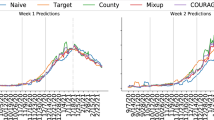Abstract
Accurately forecasting the COVID-19 spread across all states is crucial for implementing effective measures to control its transmission and minimize its impact. Since the virus’ spread in one state can significantly affect other states over time through connections between them, a graph structure with temporal data is needed to capture the interdependence of COVID-19 spread among the states in the United States. In forecasting tasks that involve complex spatial and temporal dependencies, it is crucial to ensure that the model captures these dependencies accurately. In this study, we implemented an Attention Temporal Graph Convolutional Network based model for COVID-19 mortality long-term prediction which can effectively capture these dependencies. This model incorporates attention that enables us to weigh the significance of different time points and focus on the most informative data, including both adjacent and distant time points that capture the temporal dynamics accurately. For capturing spatial dependencies, we assessed the impact of using Pearson’s correlation and Mutual Information to establish connections between highly dependent states. Our experiments showed that our model, particularly when utilizing mutual information, outperformed the existing baselines and the models that only consider neighboring states resulting in lower sMAPE and MAE values. This emphasizes the importance of selecting the appropriate technique for accurate COVID-19 forecasting in each state. Furthermore, our model achieved the second-highest performance among the forecasting models submitted to the Centers for Disease Control and Prevention.
Supported by University of Georgia.
Access this chapter
Tax calculation will be finalised at checkout
Purchases are for personal use only
Similar content being viewed by others
References
CDC Covid Tracker: https://covid.cdc.gov/covid-data-tracker/#forecasting
Chimmula, V.K., Reddy, L.Z.: Time series forecasting of COVID-19 transmission in Canada using LSTM networks. Chaos Solitons Fractals 135, 109864 (2020)
Kumar, S., et al.: Forecasting the spread of COVID-19 using LSTM network. BMC Bioinformatics 22(6), 1–9 (2021)
Pavan, K., et al.: Forecasting the dynamics of COVID-19 pandemic in top 15 countries in April 2020: ARIMA model with machine learning approach. MedRxiv (2020)
Chinazzi, M., et al.: The effect of travel restrictions on the spread of the 2019 novel coronavirus (COVID-19) outbreak. Science 368(6489), 395–400 (2020)
Ferguson, N.M., et al.: Strategies for mitigating an influenza pandemic. Nature 442(7101), 448–452 (2006)
Kapoor, A., et al.: Examining covid-19 forecasting using spatio-temporal graph neural networks. arXiv preprint arXiv:2007.03113 (2020)
Mahmud, S., et al.: A human mobility data driven hybrid GNN+ RNN based model for epidemic prediction. In: 2021 IEEE International Conference on Big Data (Big Data). IEEE (2021)
Panagopoulos, G., Nikolentzos, G., Vazirgiannis, M.: Transfer graph neural networks for pandemic forecasting. In: Proceedings of the AAAI Conference on Artificial Intelligence, vol. 35, no. 6. (2021)
Rozemberczki, B., et al.: Pytorch geometric temporal: spatiotemporal signal processing with neural machine learning models. In: Proceedings of the 30th ACM International Conference on Information & Knowledge Management (2021)
Wang, Lijing, et al.: Using mobility data to understand and forecast COVID19 dynamics. medRxiv (2020)
Xue, J., et al.: Multiwave covid-19 prediction from social awareness using web search and mobility data. In: Proceedings of the 28th ACM SIGKDD Conference on Knowledge Discovery and Data Mining (2022)
Cramer, E.Y., et al.: Evaluation of individual and ensemble probabilistic forecasts of COVID-19 mortality in the United States. Proc. Natl. Acad. Sci. 119(15), e2113561119 (2022)
Fritz, C., Dorigatti, E., Rögamer, D.: Combining graph neural networks and spatio-temporal disease models to predict covid-19 cases in Germany. arXiv preprint arXiv:2101.00661 (2021)
Cao, D., et al.: Spectral temporal graph neural network for multivariate time-series forecasting. Adv. Neural. Inf. Process. Syst. 33, 17766–17778 (2020)
Bai, J., et al.: A3t-GCN: attention temporal graph convolutional network for traffic forecasting. ISPRS Int. J. Geo Inf. 10(7), 485 (2021)
Kipf, T.N., Welling, M.: Semi-supervised classification with graph convolutional networks. arXiv preprint arXiv:1609.02907 (2016)
Vaswani, A., et al.: Attention is all you need. In: Advances in neural Information Processing Systems, vol. 30 (2017)
Learned-Miller, E.G.: Entropy and mutual information, p. 4. University of Massachusetts, Amherst, Department of Computer Science (2013)
Dong, E., Hongru, D., Gardner, L.: An interactive web-based dashboard to track COVID-19 in real time. Lancet. Infect. Dis 20(5), 533–534 (2020)
Paszke, A., et al.: Pytorch: an imperative style, high-performance deep learning library. In: Advances in Neural Information Processing Systems, vol. 32 (2019)
Smyl, S., Ranganathan, J., Pasqua, A.: M4 forecasting competition: introducing a new hybrid ES-RNN model (2018). https://eng.uber.com/m4-forecasting-competition
Chicco, D., Warrens, M.J., Jurman, G.: The coefficient of determination R-squared is more informative than SMAPE, MAE, MAPE, MSE and RMSE in regression analysis evaluation. PeerJ Comput. Sci. 7, e623 (2021)
JHU-IDD by Johns Hopkins University: Infectious Disease Dynamic Lab. https://github.com/HopkinsIDD/COVIDScenarioPipeline/
Computational Uncertainty Lab by Prof. Thomas McAndrew. https://zoltardata.com/model/737
Microsoft by Microsoft AI. https://www.microsoft.com/en-us/ai/ai-for-health/
Srivastava, A.: The Variations of SIkJalpha Model for COVID-19 Forecasting and Scenario Projections. arXiv preprint arXiv:2207.02919 (2022)
ESG by Robert Walraven. https://rwalraven.com/COVID19/
UCSD-NEU University of California, San Diego and Northeastern University. https://sites.google.com/view/yianma/epidemiology/
JHU-APL by Johns Hopkins University, Applied Physics Lab. https://buckymodel.com/
Karlen by Karlen Working Group. https://pypm.github.io/home/
MOBS by Northeastern University, Laboratory for the Modeling of Biological and Socio-technical Systems. https://covid19.gleamproject.org/
GT-DeepCOVID by Georgia Institute of Technology, College of Computing. https://deepcovid.github.io/
BPagano by Bob Pagano. https://bobpagano.com/
Ray, E.L., et al.: Ensemble forecasts of coronavirus disease 2019 (COVID-19) in the US. MedRXiv (2020)
Columbia by Columbia University. https://columbia.maps.arcgis.com/apps/webappviewer/index.html?id=ade6ba85450c4325a12a5b9c09ba796c
Author information
Authors and Affiliations
Corresponding author
Editor information
Editors and Affiliations
Rights and permissions
Copyright information
© 2023 The Author(s), under exclusive license to Springer Nature Switzerland AG
About this paper
Cite this paper
Rana, S., Barna, N.H., Miller, J.A. (2023). Exploring the Predictive Power of Correlation and Mutual Information in Attention Temporal Graph Convolutional Network for COVID-19 Forecasting. In: Zhang, S., Hu, B., Zhang, LJ. (eds) Big Data – BigData 2023. BigData 2023. Lecture Notes in Computer Science, vol 14203. Springer, Cham. https://doi.org/10.1007/978-3-031-44725-9_2
Download citation
DOI: https://doi.org/10.1007/978-3-031-44725-9_2
Published:
Publisher Name: Springer, Cham
Print ISBN: 978-3-031-44724-2
Online ISBN: 978-3-031-44725-9
eBook Packages: Computer ScienceComputer Science (R0)




